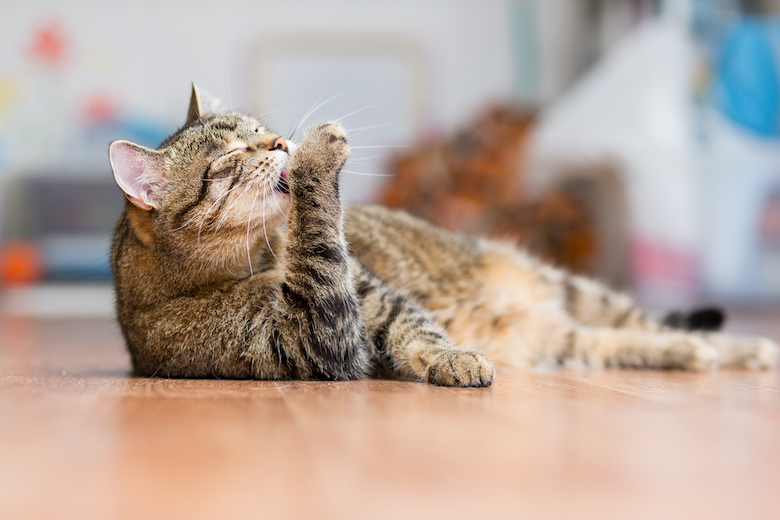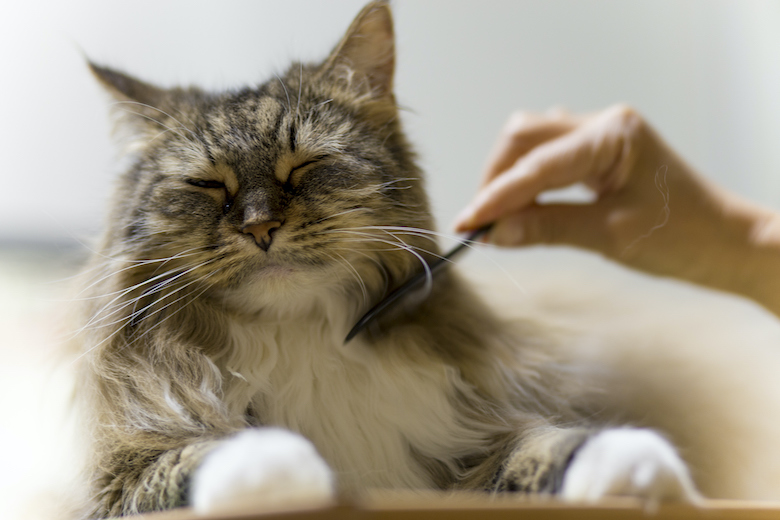When you buy through links on our site, we may earn an affiliate commission.
Even if you have an indoor cat it’s likely their coat will change seasonally.
“A cat’s undercoat will bulk up in winter months because fur growth is related more to the amount of sunlight available than ambient temperature,” says Dr. Nicole Starinsky, DVM, of the NorthStar VETS Emergency and Critical Care team.
Cats naturally groom themselves.
“Cats are typically fastidious groomers, spending many hours a day grooming themselves. This grooming keeps them clean, and keeps their skin and coat healthy by stimulating healthy coat oil development from the skin and then distributing these oils throughout the coat. It also helps reduce loose hair, similar to when we humans brush our hair” says Dr. Jamie Richardson Medical Chief of Staff at Small Door Veterinary.
You’ll likely notice your cat increasing their grooming during the winter months to keep up with the thicker coat. But, your cat may need some extra grooming help to keep up with the extra fur during the winter season.

Your cat’s winter grooming needs
The amount of grooming your cat needs is going to depend on the kind of coat your cat has and your cat’s age. Short-haired cats may not need grooming at all or a quick brush each week.
“For cats with long coats, or cats who are a bit older, may be arthritic or have difficulty grooming due to obesity, you may need to brush more often” says Dr. Richardson.
Related: Senior Cat Grooming — What to Know and What to Do
Not only will cats have different grooming needs in different seasons, but their grooming needs in the winter may also vary at different times in their life. Dr. Starinsky advises to “always keep an eye on your cat’s coat, especially as they age, since they may require more brushing at that later stage of life.” For example, my long-haired 20-year-old cat has significantly cut back on how much she grooms herself, meaning we have to brush her more regularly, especially during the winter.
How to brush your cat in the winter
Regular brushing and monitoring of your cat’s coat will help prevent mats from developing and improve overall coat health. Brushing cats regularly not only helps keep their coat in good condition, it also provides an additional opportunity to bond with your cat.
Start slowly with grooming, and keep your sessions short. Dr. Richardson advises, paying particular attention to cues your cat might be giving that he’s ready for grooming to stop such as “flicking their tail, lowering the ears and growling.”
There are many cat grooming brushes on the market with different purposes. Some remove loose top hair, but don’t get into the undercoat. Talk with your cat groomer or vet about what brushes are right for your cat. Frisco’s Beginner Grooming Kit ($12.99, Chewy) has three different brushes and a pair of clippers and is a good place to start.
For grooming the undercoat, Dr. Richardson advises using a flea comb or other comb with teeth close together, noting that these combs are “more effective at lifting away dead undercoat.” These flea combs from HARTZ ($3.77, Chewy) are cost-effective and popular with cat parents.
Regular grooming is essential for coat care, but “If your cat’s coat gets matted, don’t attempt to trim it with scissors. This can lead to inadvertent injury. An appointment with a qualified groomer or your veterinarian is warranted if you cannot work the mats out with a brush or comb,” says Dr. Starinsky.
How to groom during shedding season
Although cats shed year-round they also go through larger shedding seasons twice a year generally in the spring and in the fall. That thick winter coat that your cat is growing now will go through a heavy shed during the spring, and then in the fall your cat’s coat is preparing to grow the thick winter coat. During shedding season you’ll want to increase the frequency that you groom your cat, especially cats with longer coats. Grooming during shedding season will help prevent mats and remove any loose fur.
How to determine if your cat’s coat is healthy
As part of your regular grooming routine, you’ll want to inspect your cat’s coat to ensure it is healthy.
“A healthy coat on a cat looks shiny and unmatted, and the skin underneath is clear and free of flakes and scabs. Some shedding is a sign of a healthy coat just as not shedding or excessive shedding can be a sign of illness,” says Dr. Starinsky. If while you are petting or grooming your cat take note of any changes in your cat’s fur.
In addition, Dr. Richardson advises “if you see any patches where the fur is falling out, or the skin is greasy, flaky or bumpy, you should consult a veterinarian.”
Featured Image: S_Kazeo/Getty Images
Read Next: Stella the Cat Talks Different Kinds of Cat Coats








